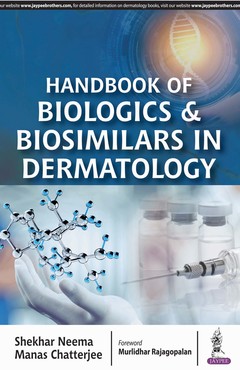Description
Handbook of Biologics & Biosimilars in Dermatology, New edition
Authors: Chatterjee Manas, Neema Shekhar
Language: English
Subject for Handbook of Biologics & Biosimilars in Dermatology:
419 p. · 15.8x24.1 cm · Paperback
Out of Print
Description
/li>Contents
/li>Biography
/li>
A drug is typically manufactured through chemical synthesis, which means that it is made by combining specific chemical ingredients in an ordered process. Biologics are medicines made from living cells through highly complex manufacturing processes and must be handled and administered under carefully monitored conditions. Biologics are used to prevent, treat, diagnose, or cure a variety of diseases including cancer, chronic kidney disease, autoimmune disorders, and infectious diseases. A biosimilar is a biologic that is similar to another biologic drug already that has already been approved.
This book is a complete guide to the use of biologics and biosimilars in the treatment of dermatologic disorders.
Beginning with an overview of the history and classification of biologics and the concept of biosimilars, the following chapters explain their therapeutic use for different skin conditions.
The final sections cover related topics such as cost effectiveness and quality of life with biologic therapy, and the book concludes with discussion on future developments and the use of small molecule treatment.
Key points
- Complete guide to use of biologics and biosimilars in treatment of dermatologic disorders
- Covers many different skin diseases and conditions
- Discusses related topics such as cost effectiveness and quality of life
- Covers future development of small molecule therapy
- History and Development of biologics
- Classification of Biologics
- Concept and development of biosimilars
- Biologics in management of psoriasis – Pathogenesis and mechanism of action
- TNF alpha Blockers
- Etanercept Infliximab
- Adalimumab
- IL-17 blockers – Secukinumab
- Anti CD6 monoclonal antibody
- Newer biologics
- Anti CD20 monoclonal antibody
- Anti IgE monoclonal antibody
- Intravenous immunoglobulins
- Miscellaneous uses of biologics
- Biologic approach to management of various diseases – when to use and which one?
- Psoriasis
- Immunobullous diseases
- Hidradenitis suppurativa
- Connective tissue diseases
- Adverse effects of biologics – feared or real?
- Management of latent tuberculosis infection
- Adult immunization prior to initiation of biologic therapy
- Cost effectiveness and quality of life with biologic therapy
- Biologics in children: Which, when, why?
- Biologics in presence of hepatitis B and C infection
- Biologics in special situation
- Small molecules
- Tofacitinib
- Apremilast
- Sirolimus
Manas Chatterjee MD DNB
Senior Adviser, Professor and Head, Department of Dermatology, INHS Asvini, Mumbai, Maharashtra, India
Shekhar Neema MD
Assistant Professor, Department of Dermatology, Command Hospital, Kolkata, West Bengal, India

